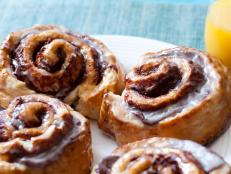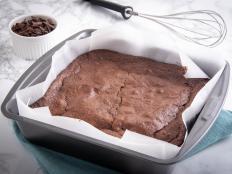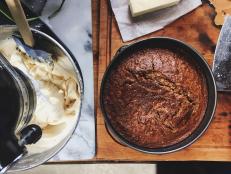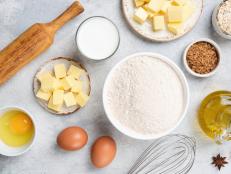The Best Flour Substitutes If You Run Out
Don’t skip a beat — just keep baking.

By Leah Brickley for Food Network Kitchen
Out of the flour? No problem — most types of flour can be substituted with ingredients you may have in the pantry. Here's our quick guide for the best swaps, plus how to measure flour the right way.
The best way to measure flour
Do you scoop your flour using the measuring cup? If you are, you could be accidentally adding up to 20% more flour to your recipe! Flour settles and compacts in the bag or storage container, so when you scoop, you’re adding unwanted flour. That means drier, crumblier baked goods.
The most accurate way to measure flour is to weigh it on a kitchen scale. Place a bowl on the scale and tare it to zero then add the amount of flour you need: 1 cup of all-purpose flour = 120 grams or 4 1/4 ounces.
If you don’t have a scale, then use the spoon-in-and-level-off method: Fluff flour with a fork to loosen it and then spoon it into a measuring cup and level it off with a straight edge like the back of a knife.
All-purpose flour
This is the go-to flour: Milled from both soft and hard wheat, it has a broad range from delicate cakes to chewy pizza dough.
To substitute all-purpose flour, weigh out equal parts bread and cake flour. If you don’t have a scale, then it's OK to measure equal parts by volume (in measuring cups) using the spoon-in-and-level-off method.
You can also use self-rising flour for recipes that have up to 1 1/2 teaspoons baking powder per cup of all-purpose flour. Be sure to omit any added salt from the recipe (self-rising flour has added salt).
Bread flour
High in protein, bread flour provides the most structure in the baked goods world. It's most ideal for sturdy breads like this homemade sourdough.
Replace bread flour with an equal amount of AP flour — your baked good will be less chewy, but not far off.
Cake flour
Generally bleached and with a low protein and gluten content, cake flour can transform cakes, scones, quick breads and muffins into extra light, tender treats.
Cake flour is easy to make: Spoon 2 tablespoons of cornstarch into a 1-cup measuring cup and spoon in and level off the rest with all-purpose flour.
Pastry flour
Somewhere between cake and all-purpose, pastry flour is unbleached and strikes the right balance for baked goods that are both flakey and tender like pie and tart dough and even some cookies.
Harder to find, pastry flour is easy to make: Use a ratio of 2/3 cup all-purpose flour + 1/3 cup cake flour.
Self-rising flour
A Southern staple, this flour has baking powder and salt added to it. It’s perfect for tender biscuits and puffy pancakes.
Make your own self-rising flour: 1 cup all-purpose flour + 1 1/2 teaspoons baking powder + 1/4 teaspoon salt.
Whole-wheat flour
The milling process strips wheat of the germ (embryo) and bran (outer coating): Whole-wheat flour has both the germ and bran added back making it richer in nutrients but less able to form gluten, thus resulting in heavier baked goods.
For a whole-wheat sub: Use 3/4 cup all-purpose flour + 1/4 cup wheat germ (the nutritional profile won’t be the same as regular whole-wheat flour). Or look for white whole-wheat flour, which has the same nutrients but is milled from a different type of grain.
Related Links:

























.jpg.rend.hgtvcom.231.174.suffix/1681323015319.jpeg)








